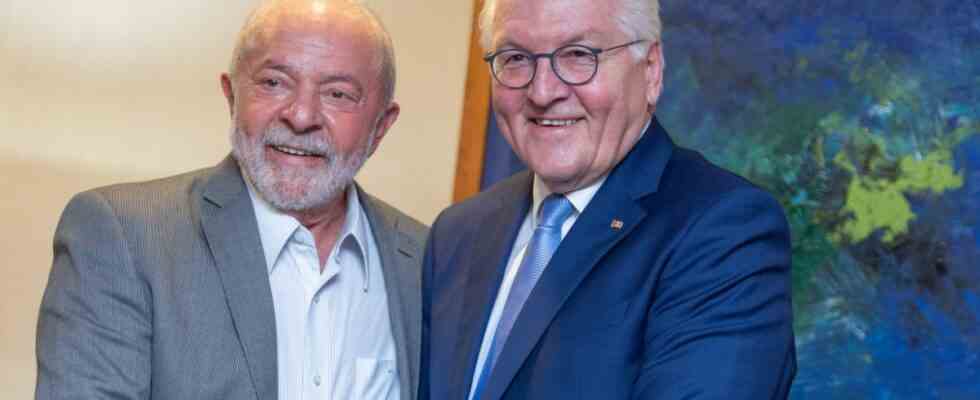In order to see the South American rainforest from above, Frank-Walter Steinmeier will climb hundreds of steps at the beginning of the new year: In the Amazon region, the Federal President wants to visit the Atto Observatory (Amazon Tall Tower Observatory) this Monday, a scaffold-like, 325-meter-high tower . There, far above the dense treetops, researchers are investigating the interaction between forest and air. Steinmeier will not make it to the top, but the ascent to the first platform at a height of 54 meters is considered sweaty enough in tropical temperatures and a 70 percent chance of rain.
The President’s visit to the Amazon has great symbolic importance: in 2023, the German head of state and the federal government are not only hoping for a political restart in German-Brazilian relations with the newly elected President Luiz Inácio Lula da Silva, who was inaugurated on New Year’s Day, but also to more environmental protection. Before leaving, Steinmeier spoke of an impulse “for our common goal of protecting the Amazon rainforest, the green lung of our world, from deforestation”. From a German perspective, Brazil is an essential partner in the fight against the global climate crisis. Lula is much more interested in the environment than his predecessor Jair Bolsonaro. While Bolsonaro tolerated large parts of the forest being destroyed for commercial purposes, Lula recently announced at the climate conference in Sharm el-Sheikh that deforestation would be stopped by 2030.
The 325 meter high ATTO Observatory surrounded by the Brazilian rainforest.
(Photo: Yesica Fish/AP)
Germany’s commitment to Brazil’s rainforest has a long tradition. At the end of the 1980s, Chancellor Helmut Kohl discovered the special value of this green lung. At the 1990 G-7 summit in Houston, Texas, he pushed through the “Pilot Program to Conserve Tropical Forests in Brazil” (PPG7). The seven most important industrial countries, the European Community and the World Bank wanted to provide hundreds of millions of dollars, Germany alone pledged 250 million marks. But the G-7 initiative was better intentioned than done, and it fell asleep a good ten years after it was created. Instead, the Amazon Fund to protect the rainforest was set up – now under Brazilian leadership.
Germany wants to reward stopping deforestation
Germany now also wants to support Lula’s forest agenda through him. It is based on a United Nations mechanism that aims to reward people who stop deforestation. So far, the Amazon fund has mainly been filled by Norway and to a lesser extent by Germany (previously 55 million euros), but the money was recently frozen due to the differences with Bolsonaro. Now that Lula is taking office, things could start flowing again, and the federal government is likely to increase its contribution. The federal government considers Lula’s environmental policy signals to be “encouraging”.
This also recently included the appointment of Marina Silva as the new Minister for the Environment. She is considered a dedicated campaigner for the rainforest. She was Environment Minister during Lula’s first term, but resigned after five years over a dispute over the protection of the Amazon. She wishes her new colleague “a lot of success and a happy hand,” said Germany’s Environment Minister Steffi Lemke (Greens) these days, in German, English and Portuguese. “Brazil is an important partner in the fight for climate protection and nature conservation.”
Climate protection through the power of nature
This is another reason why Lemke accompanies the Federal President on his journey, up to the tower in the rainforest. For Lemke, who wants to rely more on the power of nature when it comes to climate protection, Brazil is rich in illustrative material. Her visit to the site is correspondingly longer. She visits the monitoring agency in Manaus that is supposed to put a stop to illegal deforestation. In the Anavilhanas National Park, she talks about the cooperation of a network that is intended to ensure the protection of the Lower Rio Negro, which in turn not only benefits the climate, but also biodiversity.
It was only in December that Lemke negotiated the preservation of biodiversity at the UN Nature Conservation Conference in Montreal – including by designating more protected areas on land and in the sea. This fits in with a number of projects that Lemke wants to look at in the state of Pernambuco, including an initiative dedicated to protecting coastal ecosystems and fighting marine litter, supported by German development funds. Recife is also the capital of the state of Pernambuco – one of the regions in the world most affected by climate change. Lemke will be in Brazil for almost a week, a hotspot for all sorts of environmental problems, but also for all sorts of solutions.
By the way, the answer from Lemke’s new colleague Marina Silva didn’t take long, she came via Twitter. “We will stand together,” she wrote, “to tackle the serious problems of climate change together.” A start has been made.

